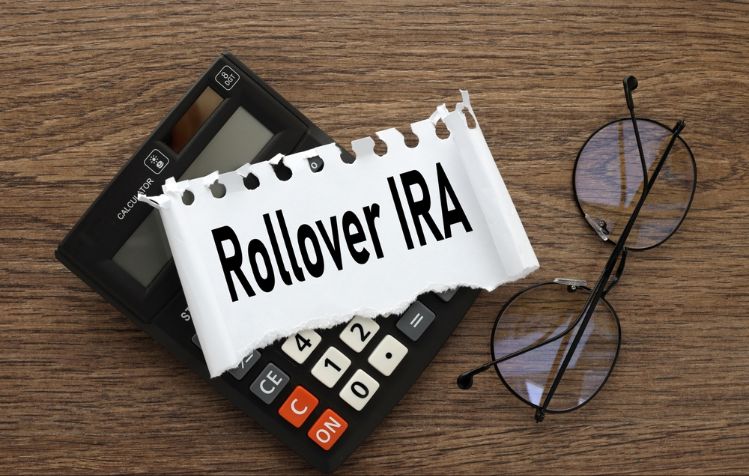Did you know that IRA rollovers are one of the most common ways to fund your Individual Retirement Account (IRA)? Further, the most common type of rollover is a transfer of funds from a workplace 401(k) when you leave a job. In the following, we’ll discuss what a rollover is, why you may want to do one, and how to perform one.
What is an IRA rollover?
An IRA rollover moves funds from one retirement account into another IRA, commonly from a workplace 401(k) after leaving a job. Rollovers can be direct or indirect.
Why should I do an IRA rollover?
The most common reasons to perform a rollover is when you want to Consolidate multiple retirement accounts, gain access to better investment options, or reduce fees compared to an employer-sponsored plan.
What Is an IRA Rollover?
In its simplest terms, an IRA Rollover is when you move assets from one retirement account into an IRA. For example, you have a 401(k) at a job you are leaving. You can choose to leave your assets there, or roll them over into an existing (or new) rollover IRA. It’s fairly easy to do and can be done directly or indirectly.
There are basically two types of rollovers: Indirect and Direct. A Direct rollover, also referred to as a trustee-to-trustee transfer is the easiest and safest way to roll over funds. An Indirect rollover gives you more flexibility, but there are some risks involved.
Indirect Rollover vs. Direct Rollover
Deciding on how you want to move your funds is a personal choice. As stated above, the direct transfer of funds from one retirement account to another is easiest. However, be aware that indirect rollovers can have income tax implications if not completed within the specified time frame. You simply request your plan administrator to transfer funds from your current plan to the trustee of your IRA. You can rollover funds from any type of plan including a 401(k), 403(b) or another IRA.
An indirect rollover is different in that you receive the funds first, and not the new IRA. Instead of sending funds directly to the IRA, you will receive a check. If your intention is to just move funds to the new account, you can cash the check and fund the new account immediately. However, you do have some leeway to use those funds. In fact, you have 60 days to deposit that money into the new plan (more on that later).
Read this: 401(k) Rollovers & Possible Tax Consequences
Reasons for an IRA Rollover
The two main reasons for rolling funds into an IRA are switching jobs and looking for better investment options or lower fees from an employer sponsored retirement plan. When leaving a job with an employer’s retirement plan, rolling over funds into an IRA can provide greater investment flexibility and consolidation benefits. If you hop around from job to job, looking for the right fit, you may accrue many retirement plans.
No matter how long you are employed by a business, it’s always best to take advantage of their retirement plan, if offered. However, once you find the perfect job, what are you going to do with all those previous plans? The best thing is to roll them over into one account. You’ll thank yourself at tax time and when you hit retirement.
The other time you may wish to rollover funds is when you’re looking for another provider. Your current one may have suited you fine at first, but now you want to explore other investment options. Many IRA Financial clients take advantage of the IRA rollover to start investing with a Self-Directed IRA. Since you are limited in investment options with a more traditional custodian, a rollover is the perfect way to start investing in alternative assets. A Self-Directed IRA allows you to invest in just about anything you want.

Choosing an IRA Provider
When selecting an IRA provider, it’s essential to consider several factors to ensure you find the right fit for your retirement savings needs. Here are some key considerations:
- Fees: Look for providers with low account fees, as well as no hidden fees. Avoid providers with excessive account balance fees. High fees can eat into your retirement savings over time, so it’s crucial to choose a provider that offers competitive rates.
- Investment Options: Consider providers that offer a wide range of investment options, including stocks, and mutual funds, as well as alternative assets, like real estate and cryptos. A diverse portfolio can help you manage risk and maximize returns.
- Customer Service: Choose a provider with a reputation for excellent customer service, including online support, phone support, and in-person support. Good customer service can make managing your retirement account much easier.
- Reputation: Research the provider’s reputation online, reading reviews and ratings from other customers. A provider with a strong reputation is more likely to offer reliable and trustworthy services.
- Services: Consider providers that offer additional services, such as retirement planning, investment advice, and tax guidance. These services can provide valuable support as you plan for your retirement.
It’s essential to compare the features and fees of each provider to determine which one is best for you. By carefully evaluating your options, you can find a provider that aligns with your retirement goals and helps you build a secure financial future.
Funding a Self-Directed IRA
A Self-Directed IRA allows you to invest in alternative assets, such as real estate, cryptocurrencies, and private companies. To fund one, you can use one of the following methods:
- Contributions: You can contribute up to $7,000 in 2024 and 2025 ($8,000 if you are age 50 or older) to an IRA. These contributions can help you build a diverse portfolio that includes both traditional and alternative investments.
- Rollovers: You can roll over funds from a 401(k) or other qualified retirement plan into a Self-Directed IRA. This process allows you to transfer your retirement assets without incurring taxes or penalties, provided you follow the IRS guidelines.
- Transfers: You can transfer funds from an existing IRA to a Self-Directed IRA. This method is similar to a rollover but typically involves moving funds between IRAs rather than from a 401(k) or other employer-sponsored plan.
It’s essential to note that SDIRAs have specific rules and regulations, including the requirement to work with a custodian and to follow IRS guidelines for investing in alternative assets. By understanding these rules and working with a knowledgeable custodian, you can take full advantage of the investment opportunities offered by a self-directed IRA.
Rollover Rules
There are a few rules that can make an IRA rollover a little tricky. Failing to adhere to these rules can result in penalties and the need to pay taxes on the distributed amount. These apply to the indirect rollover mostly:

Withholding Penalty
If you receive funds personally from your administrator, the IRS will impose a withholding penalty, which can have significant income tax implications. The amount can be 10% of an IRA withdrawal or 20% from other accounts, such as a 401(k). There are no taxes withheld for a direct transfer. Also, there are no taxes withheld for a Roth IRA. The penalty is the IRS’ way of telling us to not take possession of funds for a rollover. Lastly, the entire amount (including funds that were withheld) must be deposited into your IRA.
60 Day Rollover Rule
Earlier, we mentioned you have 60 days to complete IRA rollovers from an old account. When that grace period is up, any amount not deposited into the new IRA will be treated as a distribution. It will be added to your income for the year, taxed and, if you are under age 59 1/2, you’ll get hit with a 10% early withdrawal penalty. Unless you absolutely need that money, it’s always better to opt for a direct transfer.
IRA One-Rollover-Per-Year Rule
According to the IRS, “…you can make only one rollover from an IRA to another (or the same) IRA in any 12-month period, regardless of the number of IRAs you own.” Prior to 2015, you could do as many rollovers as the number of IRAs you owned. Now, you can only do one IRA rollover in any 12-month period. For example, if you performed a rollover on June 1, 2024, you cannot do another one until June 2, 2025.
This only affects indirect rollovers and not direct transfers of one IRA to another. Moreover, this does not apply to traditional IRAs to Roth IRA rollovers, also known as conversions.
Tax Implications to Know
When rolling over a 401(k) or other qualified retirement plan to an IRA, it’s essential to understand the tax implications. Here are some key considerations:
- Direct Rollovers: A direct rollover from an employer-sponsored plan to an IRA has no tax implications. The funds are transferred directly from one account to another, maintaining their tax-deferred status.
- Indirect Rollovers: An indirect rollover involves taking a distribution from the old plan and then depositing it into the IRA within 60 days. This type of rollover is subject to income taxes and a 10% early withdrawal penalty if you are under age 59½. Additionally, 20% of the distribution will be withheld for taxes, which you must make up when depositing the full amount into the new IRA.
- Tax Withholding: If you take a distribution from a 401(k) or other qualified retirement plan, 20% of the distribution will be withheld for taxes. This withholding can complicate the rollover process, as you will need to replace the withheld amount to avoid taxes and penalties.
- Tax Advisor: It’s essential to consult with a tax advisor to determine the best course of action for your specific situation. A tax advisor can help you navigate the complexities of rollovers and ensure you make the most tax-efficient decisions for your retirement savings.
By understanding these tax implications and seeking professional advice, you can make informed decisions about rolling over your retirement accounts and avoid costly mistakes.
Conclusion
An IRA Rollover is an important tool to utilize. It can help consolidate all your old workplace retirement plans into one IRA. Further, it allows you to shop around for a plan that best suits your needs. However, it’s important to be mindful of all the rules surrounding an IRA Rollover.
The bottom line – rolling over your retirement account can help you consolidate funds, reduce fees, and access better investments. However, understanding the rules is crucial to avoid costly taxes and penalties.
Frequently Asked Questions
What is an IRA Rollover?
An IRA rollover moves funds from one retirement account into another IRA, commonly from a workplace 401(k) after leaving a job.
What are the two types of rollovers?
Direct Rollover: Funds go directly from your old account to the new IRA (safest and avoids tax penalties).
Indirect Rollover: You receive a check and have 60 days to deposit the funds into a new IRA, or you’ll face taxes and penalties.
Why should I do an IRA rollover?
Consolidate multiple retirement accounts for easier management.
Gain access to better investment options, especially with a Self-Directed IRA.
Reduce fees compared to an employer-sponsored plan.
What are the risks of an indirect rollover?
You must deposit the full amount within 60 days, or it becomes taxable income.
A 20% tax withholding applies to indirect rollovers from a 401(k), which you must make up when redepositing funds.
How often can I do an IRA rollover?
The one-rollover-per-year rule allows only one indirect IRA-to-IRA rollover in a 12-month period. Direct rollovers and Roth conversions are not affected by this rule.
What tax implications should I consider?
Direct Rollovers: No immediate tax implications.
Indirect Rollovers: Subject to withholding taxes if not completed properly.
Roth IRA Conversions: You’ll pay income tax on the converted amount but gain tax-free withdrawals in retirement.
Can I roll over into a Self-Directed IRA?
Yes! A Self-Directed IRA allows investment in alternative assets like real estate, private businesses, and cryptocurrencies, which aren’t available in standard IRAs you can open at a bank.
What’s the best way to avoid penalties?
Always choose a direct rollover whenever possible.
If doing an indirect rollover, redeposit the full amount within 60 days.
Work with a financial advisor to ensure compliance.





